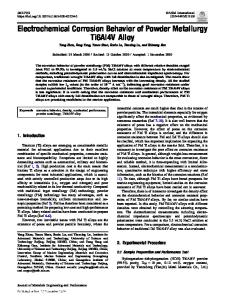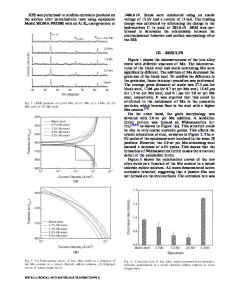Corrosion Behavior of Additive Manufactured Ti-6Al-4V Alloy in NaCl Solution
- PDF / 4,745,118 Bytes
- 11 Pages / 593.972 x 792 pts Page_size
- 28 Downloads / 336 Views
INTRODUCTION
TI-6AL-4V alloy can be extensively applied in fields of aerospace, marine, energy, and medical implant industries due to its combination of excellent strength, fracture toughness, low density, and high biocompatibility.[1,2] However, these service environments are usually highly corrosive, corrosion resistance has been a vital evaluation indicator for the applications of Ti-6Al-4V alloy.[3,4] Nowadays, Ti-6Al-4V parts with customized and complicated geometries have been produced by an emerging technology, additive manufacturing (AM).[5,6] Also, their properties are comparable or even superior to those prepared through conventional processing routes.[7–9] AM refers to layer-by-layer shaping and solidification of metal powders or wires to a wide range of configurations by a computer-controlled energy source. Simply, AM technologies can be classified in terms of the used energy source including laser beam (e.g., selective laser melting, SLM),[10,11] and electric arc beam (e.g., wire and arc additive manufacturing, WAAM).[12,13] During SLM, a focused laser beam is applied to melt and consolidate a thin metal powder layer in the powder bed within a protected atmosphere. So, SLM is characterized by a better surface roughness and higher geometrical accuracy, which is thus appropriate to manufacture small-scale metal parts with higher level of complexity.[14] Alternatively, during WAAM, metal
JINGJING YANG, HUIHUI YANG, HANCHEN YU, ZEMIN WANG, and XIAOYAN ZENG are with the Wuhan National Laboratory for Optoelectronics, Huazhong University of Science and Technology, Wuhan 430074, People’s Republic of China Contact e-mail: [email protected] Manuscript submitted September 25, 2016. METALLURGICAL AND MATERIALS TRANSACTIONS A
wire is fed at a controlled rate into an electric arc and melted onto the substrate or as-deposited layer in an ambient atmosphere. WAAM has a variety of advantages of higher deposition rate and fewer defects, in spite of lower resolution. WAAM is therefore preferred for large-scale structural components with medium to low level of complexity.[15] Also, the solidification conditions of SLM and WAAM technologies are predicted to be different by thermal modeling due to various energy sources, as shown in Table I.[16] Clearly, compared with WAAM, thermal gradient, cooling, and solidification rates of SLM process are at least an order of magnitude higher, owing to its lower heat input, smaller molten pool, and higher scanning speed. Besides, various energy sources and solidification conditions between SLM and WAAM also induce the distinctions between their microstructures.[8] It has been widely reported that both SLM and WAAM technologies processed Ti-6Al-4V samples consist of columnar b grains growing epitaxially along the negative direction of heat flux; however, the grains of the as-SLMed samples are finer than those of arc-deposited ones.[17–19] As a consequence, the properties (including hardness, tensile properties,[20,21] and fatigue performance[19,22]) of Ti-6Al-4V samples produced by the two AM p
Data Loading...











